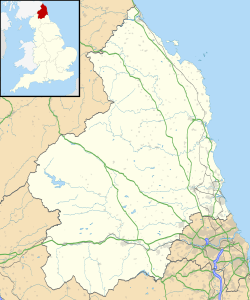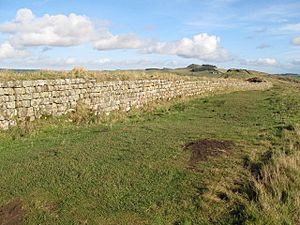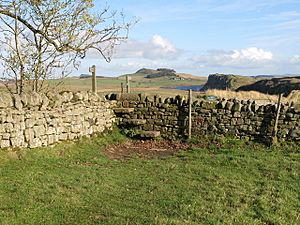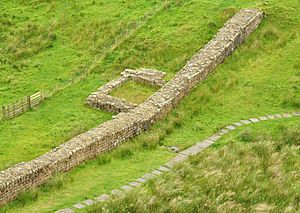Milecastle 39 facts for kids
Quick facts for kids Milecastle 39 |
|
|---|---|

The remains of Milecastle 39, near Steel Rigg
|
|
| Type | Milecastle |
| Place in the Roman world | |
| Province | Britannia |
| Structure | |
| — Stone structure — | |
| Size and area | 19 m × 15.5 m (0.03 ha) |
| Location | |
| Coordinates | 55°00′13″N 2°22′33″W / 55.003602°N 2.375725°W |
| County | Northumberland |
| Country | England |
Milecastle 39, also called Castle Nick, is a small fort on Hadrian's Wall. This famous wall was built by the Romans across northern England. Milecastles were like mini-forts placed along the wall. They helped soldiers guard the area and control who passed through.
Contents
What is Milecastle 39?
Milecastle 39 is located northeast of a place called Once Brewed. The stone walls of this milecastle are still standing. Some parts are as tall as 1.75 meters (about 5.7 feet). The fort measures 19 meters (about 62 feet) long and 15.5 meters (about 51 feet) wide.
Exploring Milecastle 39's Past
Archaeologists have explored Milecastle 39 many times. The first time was in 1854, when the site was cleared. More detailed digs happened between 1908 and 1911. Later, from 1982 to 1987, new excavations took place.
During these digs, experts found some interesting things. They discovered a stone oven in one corner. In another corner, there was a rectangular building with a sunken floor. Roman objects were found there, too. It seems that soldiers used this milecastle until the late 300s AD. In the 1700s, a possible milking house was built in the west corner.
Meet the Turrets: 39A and 39B
Every milecastle on Hadrian's Wall had two smaller watchtowers called turrets. These turrets were placed about one-third and two-thirds of a Roman mile to the west. Soldiers from the milecastle likely guarded these turrets. The turrets linked to Milecastle 39 are Turret 39A and Turret 39B.
Turret 39A (Peel Crag)
Turret 39A, also known as Peel Crag, was found in 1909. It was excavated in 1911. Archaeologists learned that this turret was abandoned and taken apart around the end of the 2nd century. They even found the burial of a man and a woman in its northwest corner. Today, you can still see a slight rectangular dip in the ground where the turret once stood. It's about 20 centimeters (8 inches) deep.
Turret 39B (Steelrigg)
Turret 39B, or Steelrigg, was also excavated in 1909 and 1911. Like Turret 39A, it was abandoned and dismantled around the end of the 2nd century. There are no visible remains of this turret today.
The Mystery of Peel Gap Tower
In the summer of 1987, something new was discovered near Hadrian's Wall. Archaeologists found the foundations of a Roman tower called Peel Gap Tower. It was located between Turret 39A and Turret 39B. This tower was built shortly after the main wall was finished. It wasn't built into the wall like other turrets. Instead, it was built right up against it. This suggests it was added later.
The tower's foundations are rectangular, measuring 4 meters (13 feet) east to west and 3.59 meters (11.8 feet) north to south. Its walls were about 0.91 meters (3 feet) thick. The doorway was found to be blocked up. This tower likely filled the longest known gap between two turrets along Hadrian's Wall.
Visiting Milecastle 39 Today
You can visit Milecastle 39, the sites of its two turrets, and the remains of Peel Gap Tower. They are all accessible by walking along the Hadrian's Wall Path. The famous Sycamore Gap Tree is also very close by.





